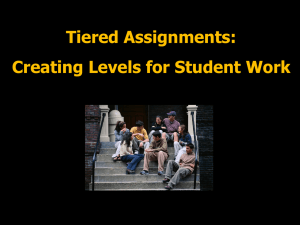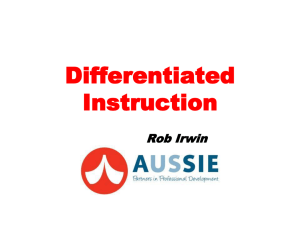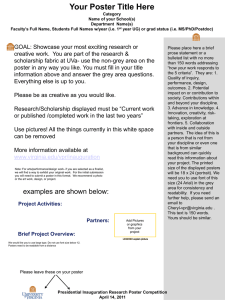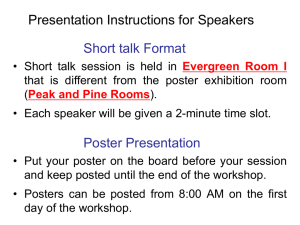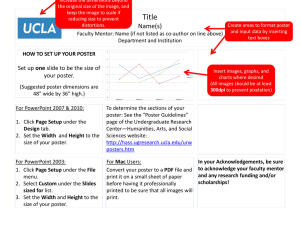Less Complex Task (Loosened)
advertisement
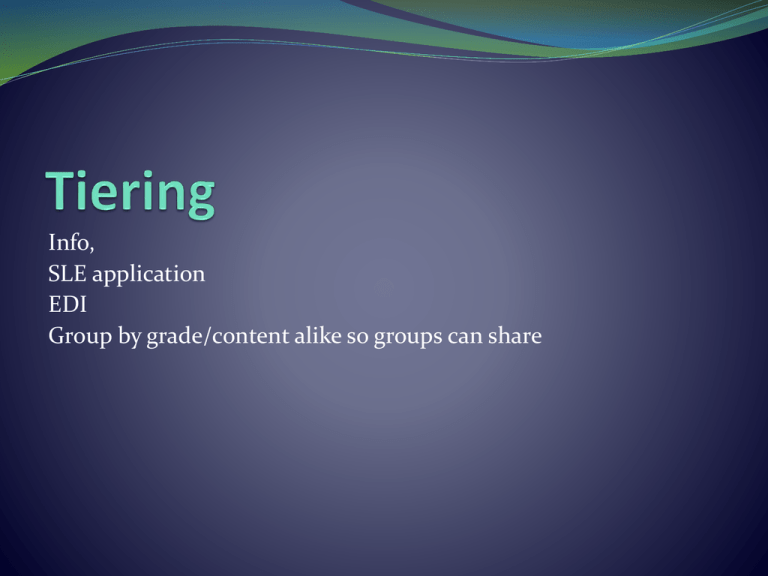
Info, SLE application EDI Group by grade/content alike so groups can share PLC: Professional Learning Communities 4 Crucial Questions Preparing Sorting & Analyzing Identifying Learning Needs Differentiating Instruction SLE, Iowa each Core What do we want student Scaffold & Deconstructing Rubrics, or SMART goals to learn, know, be able to do? What evidence do we have of Formative and Summative Assessments Student Self –Assessment the learning? How will we respond when some Differentiated Strategies students don’t learn? Considering: Interest, Profile, and Readiness and Content, Process, Product, Learning Environment How will we respond to those who have already learned? Role of Assessment Cassandra Erkens, 2008 Anam Cara Consulting, Inc http://www.anamcaraconsulting.com Reflection If…then… Individual Profile Interests Readiness Be thinking about how you might tier activities. Content Process Product Learning Environment Differentiated Instruction Continuum Not Differentiated “One-Size-Fits-All” Highly Differentiated Assessment Learning Profile Tiered Activities Curriculum Compacting Learning Contracts Independent Study Flexible Grouping Anchor Activities Learning Centers/Stations Problem-Based Learning Project-Based Learning Instruction can be differentiated for individual profiles, interests, and readiness by adjusting: Content – what students will learn and the materials that represent that learning Process – methods students use to make sense of the content Product – how students will demonstrate what they know, understand or are able to do Learning Environment – the culture and surroundings in which students learn best SDE’s Tiering Definition Tiering is a strategy that enables educators to address one concept at multiple levels of complexity based on students’ readiness levels in order to ensure student success. Remember… “More Complex” does not mean more work and “Fair” is not always equal. Tiering IS… Driven by assessment Providing opportunities for all students to learn the same concepts at varying levels of complexity Ensuring the content standards are met for all students Tiering is NOT: X X X X An IEP for each student Choice for students Tracking Used every day Unpack the Standards CONCEPT: Story Setting Tiering Example: Story Setting ALL STUDENTS WILL: Be given a story to read Be required to take notes on the characters and setting Be required to make a poster CONCEPT: Story Setting Just Right: Think about the setting in the story you have read. Using words and pictures, create a poster that shows how the setting affects the characters and their actions in the story. Less Complex Task (Loosened): Think about the setting in the story you have read. Using words and pictures, create a poster that shows the setting of your story. Tiering Example: Story Setting What was varied in the tiered assignments? Reference Material Task Structure Demonstration of Understanding Tiering Example: Story Setting What was constant in the tiered assignments? The concept of Story Setting Reading a text Taking notes and applying knowledge The product: creating a poster to show what they learned Let’s try it! With your table team, try adding a tier assignment on the next 2 slides. EXAMPLE: READING Elementary CONCEPT: Reading comprehension of persuasive text More Complex Task (Tightened): With your group, examine two newspaper advertisements, paying special attention to the word choice. Design your own advertisement to promote your new product, a homework-completing robot, and be prepared to explain why you chose the words you did. Just Right: With your group, examine two newspaper advertisements. Circle words that are used to persuade the consumer. Which advertisement did a better job persuading you? Why? Less Complex Task (Loosened): LOOSEN IT EXAMPLE: LANGUAGE ARTS Elementary CONCEPT: Story elements (Setting) TIGHTEN IT More Complex Task (Tightened): Just Right: Think about the setting in the story you have read. Using words and pictures, create a poster that shows how the setting affects the characters and their actions in the story. Less Complex Task (Loosened): Think about the setting in the story you have read. Using words and pictures, create a poster that shows the setting of your story. Key Concepts of Tiering Each task is centered on the same concept. Level of complexity varies to address different readiness levels. In all of the examples, the students should feel okay about working on them because the tasks were similar. When should I tier? When some have it and some don’t As needed Important Points Lessons tiered according to the readiness of the student will consist of ____ two or more levels, but the work required for each level should be equally engaging and challenging. The reason to tier is to meet the learners where they are with an centered on the learning appropriately leveled activity that is __________ objective. You cannot effectively tier unless you have ______________ assessments to back your decisions on how you grouped your students and how you created the tiers. Important Points You might consider having students _ share their work among the tiers so that they can learn from each other. All students need to be involved in respectful, engaging , and challenging work. There should be teacher support for every tier. Important Points Tiering is not “watering down” the standards. The goal is for all students to master the ____________________. grade-level standards Treat tiered assignments as just part of what goes on in the classroom from time to time. Do not make an _____ issue out of tiered assignments. When a student questions why assignments are different for different groups of students, respond by stressing that this is what is best for everyone today. Important Points It is important to explain to the whole class before tiering begins equal Fair is providing what a student needs. that “____ fair is not ______.” Students need to understand that all of them have strengths and all have growth opportunities. Let students know they are all working on the same content, they are just approaching it differently. Important Points flexible grouping. Students should move in and out of Use _______ groups based on assessments for each lesson or unit. similar across the tiers. Try to make the tasks _________ It is important when tiering tasks to change the _______ nature of the assignment and not the workload. Activities across the tiers should vary in complexity. Factors that can influence complexity of a tiered lesson: Required degree of thinking Level of abstraction or depth Degree of structure Learning resources Degree of teacher assistance and support What do I need to know in order to plan a tiered lesson? The standards and learning targets along the way Ways to assess students to determine their readiness Ways to design various activities at different levels of complexity Ways to manage the flexible groups Other Activity – (Partners by content or grade) Choose an SLE (scaffold as needed) Write a tiered activity for the SLE Use Depth of Knowledge framework to examine the activity. What is the level of thinking required for each tier? How can you create each tier with a high level of complexity? Re-write if needed. Share with other teams Team Planning Choose a SLE based on student data showing a need for differentiation within core. As a team, define proficiency and scaffold as needed. Create a tiered activity using the scaffold. Share with other grade level teams. Extra Tiering Slides – Add One Element Use if you want to practice. Use as examples Use Normal View to see responses in notes section of PowerPoint EXAMPLE: MATH Elementary CONCEPT: Patterns TIGHTEN IT More Complex Task (Tightened): Just Right: Students are given a pile of “jewels” from a craft store. The students are to identify all the patterns they can make with the jewels. Less Complex Task (Loosened): Students are given a pile of colorful “jewels” from a craft store. The students are to make patterns similar to the ones the teacher has made. For example, if the teacher makes a pattern of red, blue, yellow, and green, then the student should make that pattern. EXAMPLE: MATH Elementary CONCEPT: Two-digit multiplication More Complex Task (Tightened): With your partner, create two word problems that require 2-digit multiplication to solve. Solve your new problems and use “teacher talk” to explain the process. If your partner agrees with your explanation and answer, have him/her autograph your problem. Switch roles. Just Right: With your partner, read the word problems and solve using two-digit multiplication. Use “teacher talk” to explain the process. If your partner agrees with your answer, have him/her autograph your problem. Switch roles. Less Complex Task (Loosened): LOOSEN IT EXAMPLE: MATH Elementary CONCEPT: Number sequence More Complex Task (Tightened): TIGHTEN IT Just Right: With your group, deal the one- and two-digit cards in the deck. Keep your cards face down in front of you. Each person turns over one card. As a group, put the number cards in order from least to greatest. Repeat until all cards have been played. Less Complex Task (Loosened): With your group, deal the one-digit cards in the deck. Keep your cards face down in front of you. Each person turns over one card. As a group, put the number cards in order from least to greatest. Repeat until all cards have been played. EXAMPLE: READING Elementary CONCEPT: Reading comprehension of persuasive text More Complex Task (Tightened): With your group, examine two newspaper advertisements, paying special attention to the word choice. Design your own advertisement to promote your new product, a homework-completing robot, and be prepared to explain why you chose the words you did. Just Right: With your group, examine two newspaper advertisements. Circle words that are used to persuade the consumer. Which advertisement did a better job persuading you? Why? Less Complex Task (Loosened): LOOSEN IT EXAMPLE: LANGUAGE ARTS Elementary CONCEPT: Story elements (Setting) TIGHTEN IT More Complex Task (Tightened): Just Right: Think about the setting in the story you have read. Using words and pictures, create a poster that shows how the setting affects the characters and their actions in the story. Less Complex Task (Loosened): Think about the setting in the story you have read. Using words and pictures, create a poster that shows the setting of your story. EXAMPLE: SOCIAL STUDIES Elementary CONCEPT: American symbolism More Complex Task (Tightened): Using your textbook for reference, create a colored poster displaying each of the following: the American flag, the state flag, the state bird, and the state flower. Be prepared to share the significance of each of the items. Practice the Pledge of Allegiance and / or The National Anthem and be prepared to perform it for the class. Why do you think that having a National Anthem and Pledge is important? Just Right: Using your textbook for reference, create a colored poster labeling and displaying each of the following: the American flag, the state flag, the state bird, and the state flower. Practice the Pledge of Allegiance and / or The National Anthem and be prepared to perform it for the class. Less Complex Task (Loosened): LOOSEN IT EXAMPLE: MATH Middle School CONCEPT: Characteristics of triangles More Complex Task (Tightened): Examine how triangles can be used in your everyday life or in our society, and how their characteristics make them uniquely appropriate for these functions. Illustrate these characteristics and purposes by creating a 3-D model or a poster. Include written descriptions or labels. Just Right: Compare and contrast the characteristics of triangles and the characteristics of another geometric shape. The teacher will provide you with the characteristics of the other shape. Illustrate these characteristics by creating a 3-D model or a poster. Include written descriptions or labels. Less Complex Task (Loosened): LOOSEN IT EXAMPLE: LANGUAGE ARTS Middle School CONCEPT: Idioms More Complex Task (Tightened): Create an idiom of your own. Use pictures and words to illustrate several different situations in which that idiom could be used. Include the idiom’s true meaning in the illustration. Just Right: The teacher will provide you with a list of common idioms. Choose two idioms with similar true meanings. How are they same? How are they different? Illustrate these similarities and differences through pictures and words. Include the true meanings of the idioms. Less Complex Task (Loosened): LOOSEN IT EXAMPLE: SCIENCE Middle School CONCEPT: Rock cycle More Complex Task (Tightened): As a group, research and discuss the rock cycle. Determine how excessive changes in the environment could affect each segment of the rock cycle. These changes may include excessive heat, rain, drought, flooding, cold, etc. Create a short skit depicting these changes. Include key vocabulary words. Just Right: As a group, research and discuss the rock cycle. Determine how the rock cycle is similar to another cycle. The teacher will provide you with the information on the other cycles from which you can choose. Create a short skit depicting these similarities. Include key vocabulary words. Less Complex Task (Loosened): LOOSEN IT EXAMPLE: U.S. HISTORY Middle/High School CONCEPT: Social, economic, and technological changes of the early 20th century TIGHTEN IT More Complex Task (Tightened): Just Right: With a partner, study this photo from the Great Depression. Create a poster comparing and contrasting your home and the home you see in the photograph. Explain how this room may have been used by the family and why. Less Complex Task (Loosened): With a partner, study this photo from the Great Depression. Create a poster that shows the people you see in the photo. Add call-outs of what they might be saying to each other that accurately reflect the time period. EXAMPLE: READING Elementary CONCEPT: Reading comprehension of persuasive text More Complex Task (Tightened): With your group, examine 2 newspaper advertisements, paying special attention to the word choice. Design your own advertisement to promote your new product, a homework-completing robot, and be prepared to explain why you chose the words you did. Just Right: With your group, examine 2 newspaper advertisements. Circle words that are used to persuade the consumer. Which advertisement did a better job persuading you? Why?


